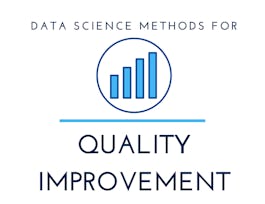This course focuses on how analysts can measure and describe the confidence they have in their findings. The course begins with an overview of the key probability rules and concepts that govern the calculation of uncertainty measures. We’ll then apply these ideas to variables (which are the building blocks of statistics) and their associated probability distributions. The second half of the course will delve into the computation and interpretation of uncertainty. We’ll discuss how to conduct a hypothesis test using both test statistics and confidence intervals. Finally, we’ll consider the role of hypothesis testing in a regression context, including what we can and cannot learn from the statistical significance of a coefficient. By the end of the course, you should be able to discuss statistical findings in probabilistic terms and interpret the uncertainty of a particular estimate.


What are the Chances? Probability and Uncertainty in Statistics
This course is part of Data Literacy Specialization
Taught in English
Some content may not be translated

Instructor: Jennifer Bachner, PhD
2,633 already enrolled
Included with 
Course
(14 reviews)
Recommended experience
Skills you'll gain
Details to know

Add to your LinkedIn profile
15 quizzes
Course
(14 reviews)
Recommended experience
See how employees at top companies are mastering in-demand skills

Build your subject-matter expertise
- Learn new concepts from industry experts
- Gain a foundational understanding of a subject or tool
- Develop job-relevant skills with hands-on projects
- Earn a shareable career certificate


Earn a career certificate
Add this credential to your LinkedIn profile, resume, or CV
Share it on social media and in your performance review

There are 4 modules in this course
The Monty Hall problem is a classic brain teaser that highlights the often counterintuitive nature of probability. The problem is typically stated as follows: Suppose you're a contestant on a game show and asked to select one of three doors for your prize. Behind one door is a car and behind the other two doors are goats. You pick one door. The host, who knows what's behind each door, opens another, which has a goat. He then gives you the option to stick with your selected door or switch to the other closed door. What should you do? The answer is that, under these circumstances, you should always switch. There is a 2/3 chance of winning the car if you switch and a 1/3 chance of winning if you stick with your original selection. Most people, however, assume that there is only a 50/50 chance of winning if you switch. Hopefully this brain teaser, and content we cover in this module, will help you better approach probabilistic problems.
What's included
4 videos5 readings4 quizzes
In this module, we'll dive into a topic you've likely encountered all of your adult life but perhaps have never explored from a statistical perspective: the normal curve. More generally, we'll discuss probability distributions, including their key features and relevance to quantifying uncertainty. Although studying probability theory can sometimes feel detached from applied statistics, it's valuable to develop a foundational understanding of probability to be able to critically evaluate statistical models. An appreciation for probability, and its counter-intuitive nature, will help you interpret the uncertainty of a statistical result as accurately as possible. This is particularly important when the stakes are high and policy makers want to know whether or not to act based on a statistical finding.
What's included
3 videos5 readings4 quizzes
In this module we will apply the concepts of probability, random variables and distributions to measuring and interpreting uncertainty. In particular, we'll focus on statistical significance. A relationship is statistically significant if it can be distinguished from zero. Suppose you want to examine the effect of exposure to negative campaign ads on one's likelihood of voting. The independent variable is one's exposure to negative campaign ads and the dependent variable is one's likelihood of voting. If we find that exposure to negative campaign ads has no relationship with the likelihood of voting, we would say that this is a statistically insignificant relationship. If, instead, we find that exposure to negative campaign ads leads to a decline in one's likelihood of voting, we have uncovered a statistically significant (i.e., non-zero) relationship.
What's included
4 videos3 readings4 quizzes
In this final module of the course, we'll cover how to measure the uncertainty of regression estimates and poll results. It is often the case that a regression model will reveal a non-zero relationship, but it's important to determine whether that relationship sufficiently different from zero such that we can conclude that the relationship is statistically significant. For example, suppose a regression model reveals that a drug improves patient outcomes by 3.2%. Is 3.2% statistically different from 0? A statistical significance test will answer this question. This module, however, will also discuss some of the drawbacks of relying a statistical significance for data-driven decision making. While statistical significance is an important consideration, it is not the only criterion one should use when determining whether to act on a set of a statistical findings.
What's included
3 videos2 readings3 quizzes1 peer review
Instructor

Offered by
Recommended if you're interested in Economics

Johns Hopkins University

Johns Hopkins University

Johns Hopkins University

University of Colorado Boulder
Why people choose Coursera for their career





Open new doors with Coursera Plus
Unlimited access to 7,000+ world-class courses, hands-on projects, and job-ready certificate programs - all included in your subscription
Advance your career with an online degree
Earn a degree from world-class universities - 100% online
Join over 3,400 global companies that choose Coursera for Business
Upskill your employees to excel in the digital economy
Frequently asked questions
Access to lectures and assignments depends on your type of enrollment. If you take a course in audit mode, you will be able to see most course materials for free. To access graded assignments and to earn a Certificate, you will need to purchase the Certificate experience, during or after your audit. If you don't see the audit option:
The course may not offer an audit option. You can try a Free Trial instead, or apply for Financial Aid.
The course may offer 'Full Course, No Certificate' instead. This option lets you see all course materials, submit required assessments, and get a final grade. This also means that you will not be able to purchase a Certificate experience.
When you enroll in the course, you get access to all of the courses in the Specialization, and you earn a certificate when you complete the work. Your electronic Certificate will be added to your Accomplishments page - from there, you can print your Certificate or add it to your LinkedIn profile. If you only want to read and view the course content, you can audit the course for free.
If you subscribed, you get a 7-day free trial during which you can cancel at no penalty. After that, we don’t give refunds, but you can cancel your subscription at any time. See our full refund policy.

